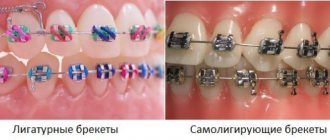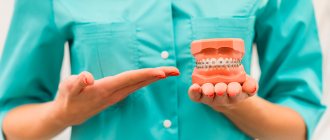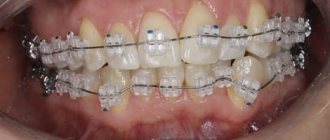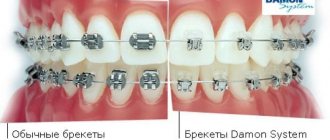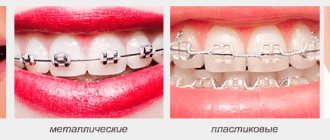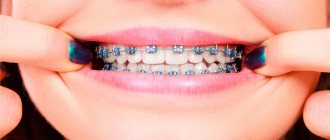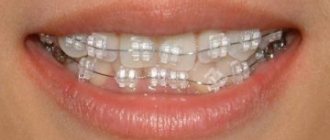May 16, 2019
When the need arises to correct the bite with braces, some patients are ready to refuse treatment simply because orthodontic devices are unattractive. However, today there are aesthetic systems, for example, made of ceramics and sapphire, but they have a high cost, which again for many is an obstacle to an ideal smile. It is for patients who want to look as beautiful as possible, but at the same time save on treatment, that doctors offer plastic braces. And the editors of the UltraSmile.ru portal have prepared useful information for you about the features of these systems.
Fact #1: Plastic braces can be colored
Plastic braces are made of plastic or polyurethane. The plastic has a natural translucent tint, so it blends in with the enamel. But at the same time, the braces can be colored - if the system is ligature, that is, the plates are connected to the arch using elastic bands, then you can choose them in a wide variety of colors - yellow, pink, red or any others. The plastic itself will remain white. This option is perfect for teenagers who are often embarrassed to wear braces.
To understand what colored plastic braces look like, look at the photo.
This is what “colored” plastic braces look like
Plastic braces are classified as aesthetic, like sapphire or ceramic, but when choosing them (like everyone else), you need to understand that their corrective arch will still be made of metal. If desired, it can be coated with a composite coating to also achieve an aesthetic white color.
Color
Plastic braces are made from plastic or polyurethane. The plastic is half transparent, so it doesn’t stand out too much against the background of the tooth enamel. But in ligature systems, color is present at the request of the patient. Ligatures are small rubber bands attached to an arched wire. And such elastic ligatures acquire a variety of colors: purple, orange, pink and others. The color version will be suitable for teenagers who often have problems with wearing braces.
Fact No. 2: plastic braces are only vestibular and ligature
Vestibular are those that are attached to the outside of the dentition. Ligatures are systems in which the corrective arc is fixed to plastic plates using special rubber bands, which are called ligatures. In general, this is a classic version of the braces system, as in the photo. But there are no plastic orthodontic devices that are more comfortable and require fewer visits to the orthodontist with self-ligating or invisible lingual ones (attached to the lingual side of the dentition). This is due to the fragility of the material.
Such braces are only vestibular and ligature
For some patients this may be a disadvantage, because... When wearing ligature devices, you have to frequently visit your doctor (once every 3-4 weeks) to replace the elastic bands and change the traction force of the system.
Don't know where to put braces? Read our useful selection - TOP 20 dentists for bite correction. Useful information on how to find your doctor and clinic that provides quality services.
Which braces are better to install?
Each type of braces has its own advantages, disadvantages, indications and contraindications for use. All this must be taken into account by the orthodontist. After the diagnosis has been carried out in the dental clinic, the orthodontist conducts a consultation and, together with the patient, selects the most suitable system in terms of material, fastening mechanism, type of installation and price.
Sometimes the type of brace system chosen by the patient is not suitable for him due to existing contraindications. In this case, the orthodontist explains what other braces are available, selects another system for him and tries to convince the patient of the need for replacement. His recommendations are worth listening to.
The best braces for children and teenagers
For children, braces are installed after the first permanent incisors erupt at the age of 8–9 years. Braces are installed only on permanent teeth. But all malocclusions are best corrected during adolescence. At 12–17 years of age, the bones of the skull actively grow, teeth develop and become stronger. At this age, when force is applied in a certain direction, the teeth quickly move into the desired position.
Parents of a teenager with dental disorders are faced with the question of which system to choose. It all depends on the nature of the violations, the characteristics of individual types of braces, the price and preferences of the teenager himself.
Most often, metal vestibular ligature systems are installed in adolescents. This is the most reliable type of braces, capable of restoring any dental irregularities in the shortest possible time. In childhood and adolescence, such systems are installed for a period of 6 to 12 months, depending on the nature of the violations. Currently, different types of braces for children are produced in different price and quality, capable of satisfying any of their needs: with small flat clasps, multi-colored ligatures and all kinds of decorations.
Braces with colored ligatures
Plastic types of braces are often used in childhood and adolescence. They are inexpensive, almost invisible on the teeth, and systems are available with multi-colored clasps and various decorations. These types of braces look aesthetically pleasing, but are fragile, so they are designed to correct mild malocclusions.
If desired, a teenager can also be given a non-ligation system. Such types of systems as Damon Q (Ormco, USA) and Empower Metal (American Orthodontics, USA) cope well with teenage problems.
They try not to install sapphire and ceramic types of braces for children and teenagers because of their fragility and the possibility of injury from scattered fragments of the locks.
Which braces are best for adults?
The most popular among adult patients are systems that are invisible on the teeth. Of the vestibular models, these are ceramic and sapphire types of brace systems. Many adult patients insist on the mandatory installation of lingual systems.
Of the ligature types, metal braces (HT Corporation, South Korea) are often used - an inexpensive but high-quality system, ceramic Clarity (3M Unitek, USA) and sapphire Inspire ICE, transparent (Ormco, USA).
Ligation-free systems are also in demand due to their gentle action and trouble-free care. The most popular models: metal braces Damon Q, ceramic braces Damon Clear (Ormco, USA).
The patient will not be able to choose braces for himself; this can only be done in consultation with an orthodontist.
Fact No. 3: plastic systems have a number of advantages over metal ones
- plastic systems are aesthetically pleasing: metal braces have a grayish tint, they are noticeable, so not everyone chooses them, even despite their wear resistance and greater efficiency,
- The plastic is smooth: thanks to this feature, it can be used to model thin and light plates that will exactly follow the anatomical shape of the tooth. In addition, plastic products rub the mucous membrane less than metal ones and injure the soft tissues of the oral cavity during use,
- plastic is less allergenic than metal: the likelihood of a negative reaction to polyurethane and plastic is lower than to metal, although it cannot be completely excluded,
- plastic is cheaper than metal.
All of the listed qualities favorably distinguish plastic systems from metal ones in the eyes of patients, but professional orthodontists have a different opinion.
Plastic braces
Plastic brace systems are among the first aesthetic designs that successfully began to replace metal ones. Their aesthetic qualities are not inferior to similar ceramic or sapphire systems. The plastic used for their manufacture is of good quality and makes it possible to produce braces that best match the color of the patient’s tooth enamel.
The design of plastic braces is the same as that of metal or ceramic braces. It is based on braces - small plates (clasps) that are attached to the outer surface of the tooth with a special orthodontic glue. These plates are connected by a special arc, passing into the groove of each lock. The arc is fixed with ligatures, which can be rubber rings or special wire.
Each individual bracket and the arch itself are made individually for an individual patient and individually for a specific tooth. Each of these elements has its own program, which is responsible for moving the tooth to the correct position.
Correction of the bite begins immediately after installation and fixation of the entire structure. During the first 2 weeks, the patient feels some discomfort in the oral cavity - this is normal. Minor pain occurs due to the impact of braces, which, under the physical pressure of the arch, begin to put pressure on the tooth, turning and advancing it. Also during this period, there is discomfort in the mouth due to a foreign body. The brace system can rub the mucous membranes, gums and tongue (to avoid this, you can use orthodontic wax).
Fact No. 4: plastic systems quickly lose their appearance
This is perhaps one of the most significant disadvantages of plastic orthodontic appliances. Plastic has a porous structure; it easily absorbs not only dyes, but also odors. Even after drinking coffee, juice or berries, the material may darken, but it will be impossible to bleach it to its original state. Therefore, plastic products require very careful oral care, as well as adherence to a “white diet” throughout the entire treatment period.
Braces quickly lose their appearance
Read the article on the topic: 6 questions and answers about the white diet. Useful information on how to maintain the appearance of your teeth even after removing braces.
Fact #5: Plastic braces can lead to dental disease
Scientists have come to interesting conclusions1. Plastic not only accumulates dyes and odors, it becomes an excellent breeding ground for bacteria, including pathogenic microorganisms that cause serious diseases - gingivitis and periodontitis, caries and pulpitis. So, in the course of research, scientists discovered that much more bacteria accumulate on the surface of plastic braces than on the surface of metal ones. Mainly streptococci, which cause the development of caries, have increased activity.
Caries often occur after wearing the system
Fact #6: Plastic systems don't last long.
Another negative property in the “treasury of shortcomings” of plastic systems. Plastic wears out easily and is unable to withstand the heavy loads that metal or ceramic braces can withstand. The material often breaks, and plates made from it often come off from the teeth, for example, after eating hard or viscous foods. Accordingly, they either have to be re-glued (but no more than 2-3 times, provided that the plates are not damaged), or replaced with new ones - you need to pay money for such services, plus you need to find time for frequent visits to the orthodontist.
To ensure that plastic systems last as long as possible, consider models from manufacturers that have enhanced their durability in a variety of ways: for example, GAC's Elan systems (these braces are based on a metal frame), Ortho Technology's Avalon (the braces are made of polyurethane and composite), Spirit from Ormco (also have a metal frame).
This is what Spirit braces look like
Plastic braces: disadvantages
Plastic bracket systems can be considered pioneers. These are the first structures that began to displace metal ones with their high aesthetic performance. Their low cost affects the basic properties of the product. The main disadvantages of plastic braces:
- One of the significant disadvantages is the pigmentation of the material. Such a system will look ideal only for the first couple of months. Next, the plastic changes color. This material is highly susceptible to various dyes that are present in many foods. The patient will have to give up coffee, tea, many fruits and berries, some vegetables and carbonated drinks. Affects the process of darkening of plastic and smoking. There is a way out of this situation. You may prefer a system in bright colors, but then its stealth indicators will also decrease.
- The fragility of the material used. Plastic braces are significantly inferior in strength to sapphire, metal or ceramic products. They come off easily, wear out and break, which makes the treatment process longer.
- Construction costs that may increase unexpectedly. Due to the fragility of the material, the cost of treatment may also increase when the breakdown needs to be repaired. A complete replacement of the system or its repair will be paid separately from the cost of the main treatment.
- Due to the strong friction of the arc against the groove of the plate, the duration of treatment increases. If, with the help of metal products, pathology in the bite can be corrected in 1.5-2 years, then with the use of plastic braces, this period will increase to 2.5-3 years.
- Many patients prefer lingual restorations – those that can be attached to the inside of the tooth. Braces made of plastic do not belong to such designs, so it will not be possible to achieve 100% invisibility.
Some of the disadvantages of plastic orthodontic structures can be smoothed out a little by adhering to simple rules.
Rules that will help extend the life of plastic systems
What to do if your financial capabilities do not allow you to install beautiful and more durable sapphire or ceramic braces, and metal ones are repulsive due to their appearance? All that remains is to install plastic braces and carefully care for them so that they can maintain their functionality and appearance for as long as possible:
- give up hard and sticky foods,
- After each snack, thoroughly and carefully clean your mouth,
- purchase not only a suitable brush and toothpaste, but also a brush, dental floss, and irrigator. Yes, brushing your teeth will take not the standard 2-3 minutes, but 8-10 (and then only when you get used to it; at first, everything can take half an hour), but without this you won’t get a beautiful smile. And remember that the paste for cleaning the oral cavity and braces should not be abrasive, because... In this case, the plastic will quickly be damaged.
Good dental hygiene can prolong the aesthetic appearance of braces.
These rules are simple; they must be followed when wearing any orthodontic appliance, and especially when using plastic systems.
Notice
: Undefined variable: post_id in
/home/c/ch75405/public_html/wp-content/themes/UltraSmile/single-item.php
on line
45 Notice
: Undefined variable: full in
/home/c/ch75405/public_html/wp-content /themes/UltraSmile/single-item.php
on line
46
Rate this article:
( 3 ratings, average: 3.33 out of 5)
braces
- Kharaeva Z.F., Zhazaeva L.Kh., Mustafaeva F.M., Zhazaeva Z.A. Adhesive activity of bacteria to materials used in orthodontics. Journal of scientific articles. Health and education in the 21st century. No. 3. 2007 (Vol.9)
Expert “Plastic braces are not suitable for correcting severe defects and for correcting deep bites. They are recommended to be installed only if bite problems are minor. However, they are less effective than metal systems - they cannot be subjected to strong pressure, so treatment may take 2 years or more.” Orthopedic dentist Sambuev Bair Sergeevich
Consulting specialist
Sambuev Bair Sergeevich
Specialization: Orthopedic dentist Experience: 11 years
Comments
How much do plastic braces cost?
Hanna (05/25/2019 at 11:17 am) Reply to comment
- Dear Hanna! The cost of the system itself and its installation on one jaw will cost approximately 25 thousand rubles. But here it is important to take into account that these are not all expenses that can be limited to. Firstly, it is extremely rare that braces are installed on only one row. Secondly, you need to add to the amount the costs of replacing and gluing individual plates in case of their breakdown, activation of the system, expenses for professional oral hygiene (this must be carried out before starting treatment, as well as every 6 months after installing braces). After removing braces, you will also need to wear retainers and undergo a fluoride enamel strengthening procedure - this is also paid separately.
Editorial staff of the portal UltraSmile.ru (05/28/2019 at 09:13) Reply to comment
Do I need to wear retainers after plastic braces?
Lizaveta (06/14/2019 at 18:17) Reply to comment
- Dear Lizaveta! Yes, you can’t do without wearing retainers. To prevent teeth from returning to their original position after treatment with braces, they need to be secured with retainers, which will have to be worn twice as long as the braces themselves. Read the article: 11 questions about retainers - it contains all the current questions and answers on this topic.
Editorial staff of the portal UltraSmile.ru (06/18/2019 at 10:41 am) Reply to comment
I consider plastic braces to be the safest in all respects. In terms of effectiveness, they are in no way inferior to ordinary ones. I agree about viscous food, especially chips and crackers, which can be harmful.
Yulia Kvasova (07/15/2019 at 09:19) Reply to comment
I have seen children with such colored teeth several times. Apparently, this was invented for them. Do colorful plastic braces also darken quickly, or are they more durable in terms of appearance?
Maria (07/15/2019 at 09:30) Reply to comment
What are plastic braces? Can plastic braces be used to straighten the teeth of a 14-year-old child? I just wanted them to be less sensitive, and the child to feel comfortable.
Rina (07/16/2019 at 01:05) Reply to comment
How are plastic braces effective? Will there be any mark left on the teeth after wearing plastic braces for a long time? I would also like to clarify what types of braces there are and what is best to choose to restore a normal bite?
Maya (07/16/2019 at 05:47) Reply to comment
Can plastic braces be used to straighten the upper row of teeth in a teenage child? I just wanted to clarify how long-term presence of plastic in the mouth can affect the condition of the mucous membrane, will it cause an inflammatory process?
Zhanna R (07/22/2019 at 06:14 pm) Reply to comment
Are plastic braces short-lived? That is, in order to straighten the crooked teeth of a child, it is necessary to change the system a couple of times? Or will there be no need for replacement if there is slight curvature and proper use?
Milana (08/14/2019 at 11:24 am) Reply to comment
Is it true that plastic braces are the most reliable option for straightening teeth in children and teenagers? If you install plastic braces, what age is appropriate in this case?
Lida (08/14/2019 at 04:19 pm) Reply to comment
Tell me, can plastic braces cause a child to experience an allergic reaction in the oral cavity? Also, what is the best plastic braces to choose, considering that you will have to straighten 2 rows of teeth?
Olya (08/14/2019 at 17:09) Reply to comment
Why are plastic braces better than metal ones? Is it true that plastic braces are more gentle on tooth enamel without scratching it? What types of plastic braces are there?
Egor (08/15/2019 at 01:16) Reply to comment
Tell me whether it is necessary to wear plastic braces if the lower row of teeth is slightly crooked. What exactly is the advantage of plastic braces? Is it true that they do not scratch tooth enamel, unlike iron braces?
Nastya D (08/20/2019 at 10:55 pm) Reply to comment
I heard that to straighten the teeth of children and adolescents, it is best to use plastic braces. How long will a child have to wear plastic braces in order for his teeth to become completely straight?
Raya (08/20/2019 at 10:58 pm) Reply to comment
Write your comment Cancel reply
Types of braces
Currently, there is a large selection of braces made by different manufacturers. Each patient can choose the most suitable device in terms of quality and price. This can only be done by an experienced orthodontist after a thorough diagnosis.
All types of braces are divided according to the material of manufacture, type of installation and method of fastening.
Types of bracket systems based on material of manufacture
The price of braces often depends on the material used.
Metal
This is the most common material. Types of systems are produced from stainless steel with an admixture of nickel, titanium, and gold products. Metal braces made by leading manufacturers are reliable and capable of performing any function.
Advantages:
- reliability of the design - they rarely break or come off;
- suitable for correcting any dental disorders;
- high efficiency of treatment;
- a relatively short wearing period - in most cases does not exceed 1 - 1.5 years, in adolescents and children - from 6 to 12 months;
- do not require exclusion of large quantities of foods from the diet; You should limit only very hard foods, such as nuts;
- the price will be cheaper than many other designs.
Flaws:
- do not always look aesthetically pleasing;
- can injure the inner surface of the cheeks and lips (modern high-quality systems in most cases do not have this drawback);
- some metal structures (mainly containing nickel) can cause allergies;
- Patients may experience a metallic taste in the mouth.
Features of titanium braces:
- the most durable and lightest types of systems; they are easier to wear than any other metal systems;
- fully compatible with human tissues, therefore do not cause allergies;
- suitable for people suffering from any chronic diseases.
Features of gold braces:
- made of metals and alloys, gold-plated on top;
- gold does not oxidize, does not cause allergies or tissue irritation;
- looks like decoration;
- does not have a negative effect on enamel;
- have a positive effect on the functioning of the gastrointestinal tract.
- disadvantages - expensive types of systems.
How to care for metal types of braces:
- brush your teeth with a special toothbrush with V-shaped bristles; use special brushes to clean areas where it is impossible to reach with a brush;
- treat the interdental spaces with dental floss (floss) after each meal or use irrigators for rinsing where it is impossible to clean the teeth in other ways;
- Twice a year, patients should definitely have their teeth professionally cleaned in the office of a dental hygienist.
Types of bracket systems
Plastic
Made from hypoallergenic synthetic materials. They have both advantages and disadvantages. Advantages:
- lightweight, therefore often installed on children;
- the cheapest;
- hypoallergenic;
- They cope well with minor dental problems.
Flaws:
- fragile, often break;
- wearing time 1.5 – 2 years;
- significant malocclusion cannot be corrected;
- are colored with food dyes, therefore they require restrictions in the consumption of various nutrients;
- require significant restrictions in the intake of solid foods; It is not advisable to smoke or consume any coloring food substances - strong tea, coffee, pomegranate and carrot juice, beets, red wine.
Care features: the same as when installing metal braces. But care must be taken with care, as plastic is highly fragile.
Ceramic
Braces made of white or transparent ceramics are increasingly replacing the classic types of metal systems. The advantages of transparent ceramic braces are:
- lightness, comfort of wearing;
- not very noticeable in the mouth - ceramics do not give glare there;
- hypoallergenic, good compatibility with human tissues;
- quick adaptation to wearing braces, no discomfort;
- have virtually no negative impact on the speech apparatus.
Flaws:
- require longer wearing compared to metal braces (1.5 – 2 years);
- often break, especially when eating solid foods;
- ceramic braces can be colored with food dyes, but not as intensely as plastic ones;
- quite expensive.
Features of care: no different from caring for metal braces, but require a more careful attitude.
Sapphire
This type of braces is made from synthetic sapphires. Sapphire braces are an aesthetic type of system, being both an orthodontic device and a decoration.
Advantages:
- almost invisible in the mouth; the presence of braces is revealed only by the reflections of artificial sapphires;
- do not cause allergies, do not irritate tissues;
- the patient quickly gets used to them, the feeling of discomfort goes away after a few days.
Flaws:
- for complete correction of malocclusion, longer wearing is required compared to metal types of systems (2 or more years);
- fragile, therefore cannot withstand high loads and require longer wearing;
- they definitely require careful hygiene procedures, as they quickly become opaque and noticeable in the mouth;
- the most expensive.
Features of care: no different from caring for metal braces.
Sapphire braces are almost invisible on the teeth
What types of braces are there according to the method of fastening?
Any braces consist of clasps installed on each tooth and a metal wire (arch) attached to them. According to the method of fastening, all braces are divided into ligature and self-ligating.
Ligature
In ligature braces, the arch is firmly attached to the clasps using elastic or metal rings - ligatures. The system is time-tested and can be used to correct significant malocclusions.
Advantages of ligature braces:
- reliability and efficiency - suitable for correcting any malocclusion;
- relatively short wearing period - shorter than with other systems, on average - 1 - 1.5 years, sometimes more (depending on the material of manufacture);
- modern manufacturers produce different types of systems, you can choose the most suitable one;
- cheaper than non-ligature braces.
Flaws:
- in most cases, ligature braces are volumetric models that are noticeable in the mouth;
- the dentist spends a long time with the installation - an arch will need to be attached to each lock using ligatures; a highly qualified orthodontist is required, but it’s worth it;
- You will need to visit the doctor frequently - once every 1.5 months to correct the tension of the arc, as well as to change the ligatures (they often fail);
- It is more difficult to care for such a system than for a non-ligated one.
The most famous types of ligature braces, made from different materials:
Metal:
- Gemini (manufacturer - 3M Unitek, USA) - high-quality braces from a well-known company, made of medical steel; The clasps are low, so they are comfortable to wear; relatively easy to install, correction must be carried out every 1.5 - 2 months;
- Alexander (Ormco, USA) is a well-known brand in Russia; a distinctive feature is small narrow clasps that create a softer tension on the arc; wearing may take longer, but comfort is guaranteed; care is no different from other metal models;
- Metal braces (HT Corporation, South Korea) – classic ligature braces, characterized by high quality and reasonable price;
- Metal braces Pilot (Orthodent Techno, Russia) – a fairly high-quality and reliable design; the advantage is the price, several times lower than that of global manufacturers; Disadvantages include frequent allergies to the metal used.
In ligature braces, the arch is attached to the locks with elastic rings
Ceramic:
- Clarity (3M Unitek, USA) – popular, high-quality and not the most expensive ceramic braces; made of high-strength ceramics; small clasps are durable and fit freely in the mouth without causing discomfort or speech impairment; a more modern model - Clarity Advanced; a feature of these types is the protection of enamel from organic acids formed by the action of carious microorganisms;
- Reflections (Ortho Technology, USA) – relatively inexpensive popular braces; made of polycrystalline ceramics and aluminum oxide; a special feature is the “swallow tail” fastenings, which create a more reliable structure.
Sapphire:
- Pumo (Ortho Technology, USA) – classic ligature sapphire braces made of artificial stones without the use of metal; completely invisible on the teeth; treatment of system elements with zirconium dioxide allows them to be more firmly attached to the teeth; are relatively inexpensive compared to other sapphire braces;
- Radiance (American Orthodontics, USA) is also a classic, but more expensive type of system; sapphires are translucent, the color of sapphires merges with the color of the teeth, so they are almost invisible in the mouth; do not change color from food dyes;
- Inspire ICE, transparent (Ormco, USA) – unique durable sapphire brackets; are characterized by high strength and high aesthetics; However, they are fragile and do not always withstand high loads at a high cost.
Plastic:
- Spirit MB (Ormco, USA) – lightweight, aesthetic and almost invisible plastic ligature braces on the teeth; have a metal base and are used to correct minor malocclusions in children and adults; duration of treatment – 1.5 – 2 years;
- Avalon (Ortho Technology, USA) – inexpensive plastic braces with metal grooves; easy to install, comfortable to wear and care for; After installation, it is not recommended to smoke or consume coloring products; very aesthetic;
- Plastic braces (Ortolite, Russia) – plastic braces are lightweight, aesthetically pleasing, sufficiently durable and affordable.
Unligated or self-ligating
The main difference between this type of braces is the fixation of the arch without ligatures. The arc is attached to each lock using a special cap. These are softer, but at the same time effective systems. They are easy for the orthodontist to work with, and they are absolutely comfortable for the patient. There are two subtypes of non-ligature braces: active and passive. The latter are more modern; the locking caps in them do not affect the arch, which makes orthodontic treatment more physiological.
Advantages of self-ligating braces:
- more compact and invisible in the mouth;
- comfortable for the orthodontist to use and for the patient to wear;
- do not cause irritation to soft tissues;
- easy to take off and put on.
Flaws:
- longer wearing time compared to ligature models;
- high price.
Popular types of self-ligating braces made from different materials:
Metal:
- Damon Q (Ormco, USA) is the most popular and easy-to-use type of system; self-ligating braces (passive), made of durable hypoallergenic steel alloys, have small clasps that do not interfere with the patient’s comfort when eating and talking; The orthodontist can easily remove and put on the system; observation is required every 3 to 4 months, but the duration of wearing is slightly longer than with ligature braces; the model is expensive, but worth the cost;
- Empower Metal (American Orthodontics, USA) – self-ligating braces that combine active and passive effects on the arch. A very effective type of braces and costs a little less than Damon Q;
- Experience metal (GC Orthodontics, Germany) – self-ligating braces, which feature clasps made of heavy-duty, non-oxidizing metal; a very reliable and efficient system, cheaper than previous ones.
Ceramic:
- Damon Clear ceramic braces (Ormco, USA) - like all Damon products, the system is distinguished by the highest quality, reliability and aesthetics; A feature of the brand is a patented fastening device; expensive type of braces;
- Clarity SL (3M Unitek, USA) – considered ceramic braces, but some of the clasps are made of metal; This gives the system strength and reduces wearing time; Another feature is the manufacturing technology, which allows you to protect the enamel from injury; somewhat cheaper than Damon braces;
- In Ovation C (Dentsply, USA) – transparent braces coated with zirconium dioxide and do not change color; in addition, the design of the system prevents its incorrect installation; beautiful and reliable braces.
Types of braces according to the type of installation on teeth
Braces are installed on the outside or inside of the teeth. Accordingly, they are divided into vestibular and lingual varieties. Read more about installing braces in our article.
Vestibular
This is a classic type of installation of braces: the clasps are installed on the front surface of the teeth, the entire system is facing outward. Such braces are clearly visible when talking and smiling. Vestibular braces differ in the material of manufacture (metal, ceramic, sapphire, plastic) and in the method of fastening (ligature and self-ligating).
Advantages of vestibular braces:
- these are the most reliable systems, they break down less often and, depending on the material of manufacture, can withstand heavy loads;
- vestibular metal braces are the most reliable orthodontic device, with its help you can get a positive result even with the most complex malocclusions;
- The wearing period of vestibular braces is shorter than that of lingual braces;
- It is easier for the orthodontist to install them and adjust the tension of the arch.
Minuses:
- are often uncomfortable in the first days of wearing; but modern systems are often made with small locks, and the discomfort quickly passes;
- during wearing, they can injure the inner surface of the lips and cheeks; correctly selected and installed models usually do not have this drawback;
- may interfere with lip closure, chewing and diction - much depends on the experience of the orthodontist and the correct installation of braces;
- unaesthetic appearance - you can choose a system that is almost invisible on the teeth.
Lingual
They are also called internal or invisible. Lingual braces are more difficult to install, which is why they cost more. These types of braces are suitable for adult patients who do not want to show their shortcomings to others.
Advantages of lingual braces:
- invisible in the mouth;
- do not change the configuration of the face;
- Wearing lingual braces does not create psychological discomfort.
The patient's lingual braces are not visible to others
Flaws:
- more complex installation processes, archwire tension adjustments, and oral care;
- not suitable for correcting severe malocclusions;
- longer wearing period compared to vestibular models;
- may scratch the inner surface of the tongue;
- high price.
Popular types of lingual braces:
- Incognito (3M Unitek, USA) – ligature systems with small flat clasps are made of gold-containing alloys according to an individual cast; the impression is made by the orthodontist and sent to the company’s dental laboratory located in Germany; such individual systems are absolutely comfortable for the patient; they do not scratch the tongue or distort speech; the disadvantage is the long production time (about 3 months) and high cost;
- STB (Ormco, USA) – also a ligature type of braces with fairly massive clasps; material – nickel and cobalt alloy; has contraindications for installation: low tooth crowns, jaw width is less than normal, dysfunction of the temporomandibular joint; the advantage of this model is its relatively low cost;
- 2D (Forestadent, Germany) – metal self-ligating braces with flat clasps; are available in standard sets, are easy to install, but have contraindications, primarily insufficient crown height and problems with the temporomandibular joint.
Price table for different types of braces
| Type of braces | Price in thousand rubles. for one jaw | ||
| Budget | Business | Premium | |
| Metal | 25 | 35 | 100 |
| Ceramics | 50 | 80 | 100-150 |
| Sapphire | 60 | 100 | 150-200 |
| Plastic | 10 | — | — |
| Ligatures (price depends on the material of manufacture) | 30 | 45 | from 100 |
| Self-ligating (price depends on the material of manufacture) | 30 | 50 | from 100 |
| Lingual | — | 150-200 | up to 400 |
